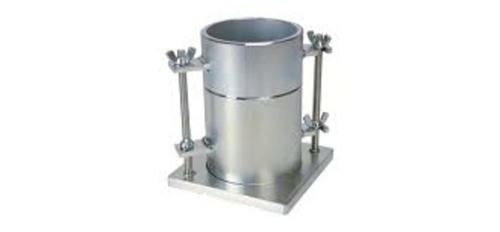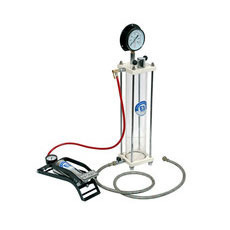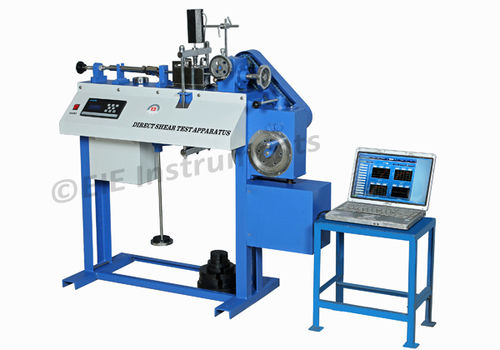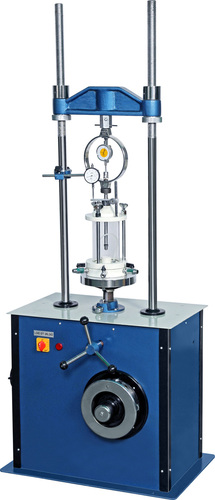Proctor Compaction Mould
Price 1.00 INR/ Piece
Proctor Compaction Mould Specification
- Automation Grade
- Manual
- Test Range
- Soil compaction suitability
- Product Type
- Proctor Compaction Mould
- Hardness
- High-grade mild steel construction
- Usage
- Soil Testing Equipment
- Dimension (L*W*H)
- 170 X 170 X 200 (L X W X D) mm Millimeter (mm)
- Specimen Size
- 100 mm diameter x 127.3 mm height
- Application
- Standard compaction mould for Soil Testing
- Mounting Type
- Free Standing
- Max Height
- 127.3 mm (specimen); 200 mm (overall incl. collar)
- Response Time
- Immediate (manual operation)
- Accuracy
- Standard as per IS: 2720 (Part VII) or ASTM D698
- Features
- Corrosion-resistant, precision machined, detachable collar
- Resolution
- Manual Reading
- Humidity
- Ambient
- Number of Specimens
- Single specimen per test
- Temperature
- Ambient
- Capacity
- 1000 cm³ (1 litre approx.)
- Machine Weight
- Approx. 8 kg
- Test Speed
- Manual (hammer drop)
- Test Width
- Compaction Mould Diameter: 100 mm
- Test Stroke
- Not Applicable (determined by hammer travel)
- Control Mode
- Manual
Proctor Compaction Mould Trade Information
- Minimum Order Quantity
- 1 Piece
- Supply Ability
- 100 Pieces Per Month
- Delivery Time
- 4 Week
- Sample Policy
- Contact us for information regarding our sample policy
- Packaging Details
- Wooden Box / Corrugated Box
- Certifications
- ISO 9001 : 2015
About Proctor Compaction Mould
- Cylindrical mould of Mild steel having volume of 1000 cc with an internal diameter and an internal effective height.
- Fitted with a detachable base plate and removable extension collar with 60mm height.
- The internal surface of the mould will be smooth.
Further details availableon our website.
The Price mentioned here are subject to change as per the capacity,specifications and application of the user.
Precision Soil Compaction Testing
This Proctor Compaction Mould offers high accuracy for standard soil compaction tests. Its precise construction ensures excellent repeatability and compliance with international standards, making it a trusted choice for laboratories, construction sites, and research institutions.
Durable and Corrosion-Resistant Design
Manufactured from high-grade mild steel and finished with powder coating or paint, the mould guarantees longevity and durability in various working conditions. The corrosion-resistant surface and strong build withstand rigorous manual compaction cycles.
Optimal Compatibility and Ease of Use
Designed for manual operation, the mould works seamlessly with either 2.6 kg or 4.89 kg compaction hammers (not included). Its detachable collar and free-standing mount allow for easy specimen preparation, loading, and extraction.
FAQs of Proctor Compaction Mould:
Q: How is the Proctor Compaction Mould used for soil testing?
A: The Proctor Compaction Mould is used for manually compacting soil samples with a standard hammer (not included) to determine the optimum moisture content and maximum dry density, following IS: 2720 (Part VII), ASTM D698, or BS 1377 procedures.Q: What are the primary benefits of using this compaction mould?
A: This mould offers precision machining, corrosion resistance, ease of assembly, and strict compliance with international standards. It delivers reliable, repeatable results for evaluating soil compaction suitability on construction sites and in laboratories.Q: When should you choose the light or heavy compaction hammer for this mould?
A: Use the 2.6 kg hammer for standard/light compaction tests and the 4.89 kg hammer for heavy compaction tests, as specified by the relevant standard. The choice depends on the soil type and the requirements of your testing procedure.Q: Where is this Proctor Compaction Mould ideally used?
A: It is ideally used in geotechnical laboratories, civil engineering sites, and academic or industrial research settings where soil properties and suitability for construction need to be evaluated.Q: What is the process for preparing a specimen in this mould?
A: To prepare a specimen, place the soil sample into the mould in layers, manually compact each layer with the specified hammer, and then remove the collar to level off the soil. The specimen is then ready for moisture and density analysis.Q: What is the capacity and specimen size compatible with this mould?
A: The mould accommodates a single specimen measuring 100 mm in diameter and 127.3 mm in height, with an approximate volume of 1000 cm (1 litre).Q: What added features does the Proctor Compaction Mould provide for users?
A: Features include a detachable collar for easy specimen handling, high-grade mild steel construction for maximum durability, powder-coated or painted finish for corrosion resistance, and precise dimensions for accurate test results.


Price:
- 50
- 100
- 200
- 250
- 500
- 1000+
More Products in Soil Testing Equipments Category
Lateral Pressure Assembly
Price 1.00 INR / Piece
Minimum Order Quantity : 1 Piece
Measuring Range : 0–10 kg/cm²
Application : Soil testing, permeability tests, triaxial tests
Max Height : 450 mm
Mounting Type : Benchtop
Universal Triaxial Cell
Price 1.00 INR / Piece
Minimum Order Quantity : 1 Piece
Measuring Range : 0 – 7000 kPa
Application : Soil mechanics testing, geotechnical engineering
Max Height : Approx. 450 mm
Mounting Type : Benchtop
Direct Shear Apparatus-Motorised - Single Speed - Electronic Digital
Price 1.00 INR / Piece
Minimum Order Quantity : 1 Piece
Measuring Range : 0 2000 N
Application : Soil Shear Strength Test
Max Height : Approx. 350 mm
Mounting Type : Benchtop
Triaxial Shear Test Apparatus
Price 1.00 INR / Piece
Minimum Order Quantity : 1 Piece
Measuring Range : 0100% (adjustable depending on transducer type)
Application : for determining the shear strength parameters of saturated soils from triaxial compression shear tests conducted under consolidated undrained conditions with measurements of pore water pressures.
Max Height : Approximately 1000 mm
Mounting Type : Table Top
 |
EIE INSTRUMENTS PVT. LTD.
All Rights Reserved.(Terms of Use) Developed and Managed by Infocom Network Private Limited. |

 Send Inquiry
Send Inquiry




